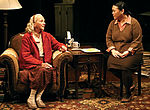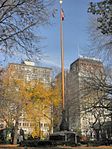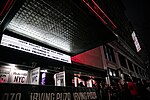Daryl Roth Theatre
1907 establishments in New York City1982 disestablishments in New York (state)1996 establishments in New York CityBanks disestablished in 1982Banks established in 1907 ... and 8 more
Defunct banks of the United StatesNew York City Designated Landmarks in ManhattanOff-Broadway theatersPark AvenueTheatres completed in 1996Theatres in ManhattanUnion Square, ManhattanUse mdy dates from November 2019

The Daryl Roth Theatre is an off-Broadway performance space at 101 East 15th Street, at the northeast corner of the intersection with Union Square East, near Union Square, Manhattan, New York City. The theater, opened in 1998, is housed in the four-story Union Square Savings Bank building, which was designed by Henry Bacon and built in 1905–1907. The original structure, a New York City landmark, houses a theater that can accommodate 300 seated or 499 standing patrons. The DR2 Theatre, located in an annex at 103 East 15th Street, seats 99.
Excerpt from the Wikipedia article Daryl Roth Theatre (License: CC BY-SA 3.0, Authors, Images).Daryl Roth Theatre
East 15th Street, New York Manhattan
Geographical coordinates (GPS) Address External links Nearby Places Show on map
Geographical coordinates (GPS)
| Latitude | Longitude |
|---|---|
| N 40.735277777778 ° | E -73.989444444444 ° |
Address
East 15th Street
10003 New York, Manhattan
New York, United States
Open on Google Maps








